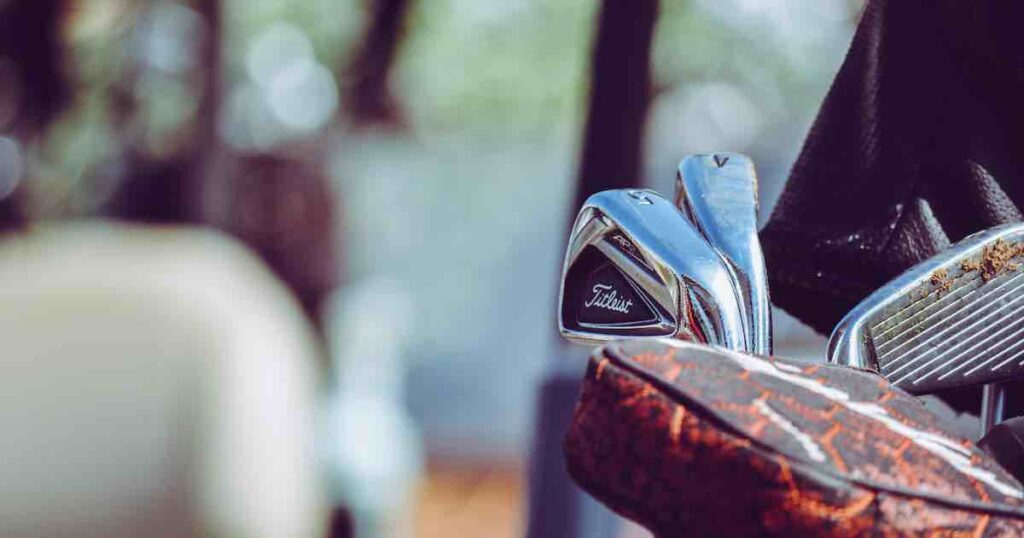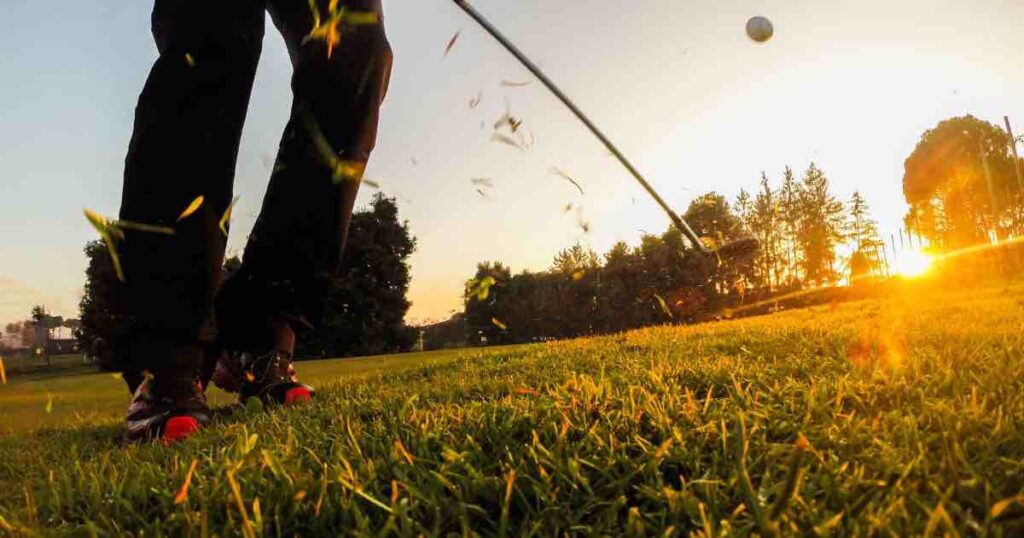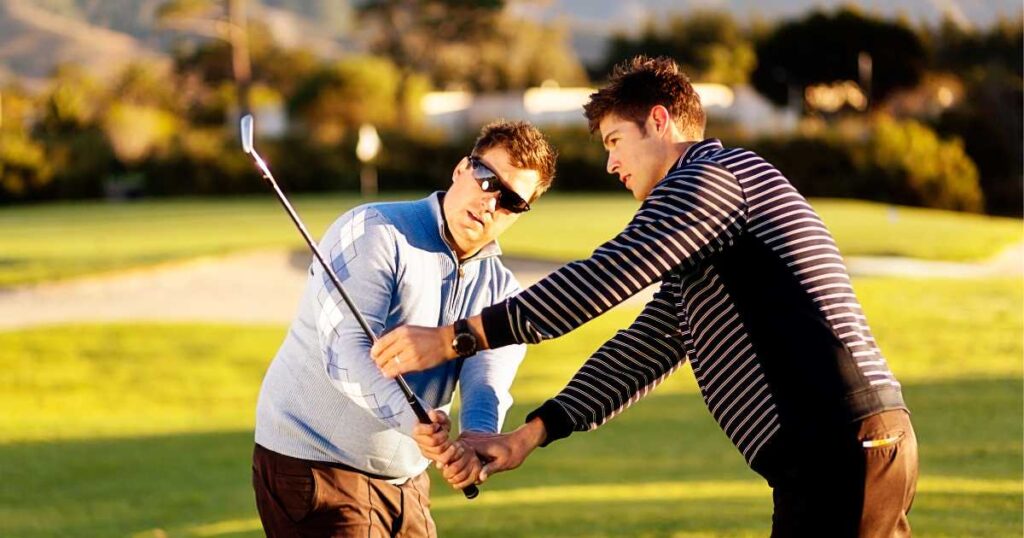If you’re struggling to stop slicing your shots, you are not alone. Hitting a slice is one of the most common issues facing golfers of all skill levels. In this post, we’ll discuss the causes of a slice and share straightforward tips to eliminate them from your game. Let’s dive into the nuances of how to fix a slice in golf.
What is a Slice in Golf?
If you’re reading this post, you probably already know what a slice is, but just in case here is a quick breakdown. A slice is a golf shot that starts to the left of the target and curves sharply to the right (for right-handed golfers). This usually results in being way off the intended landing spot or even out of bounds. A persistent slice will hinder your accuracy and distance while increasing your strokes. Understanding what a golf slice is and why it occurs is foundational for correcting your swing to hit straighter shots.
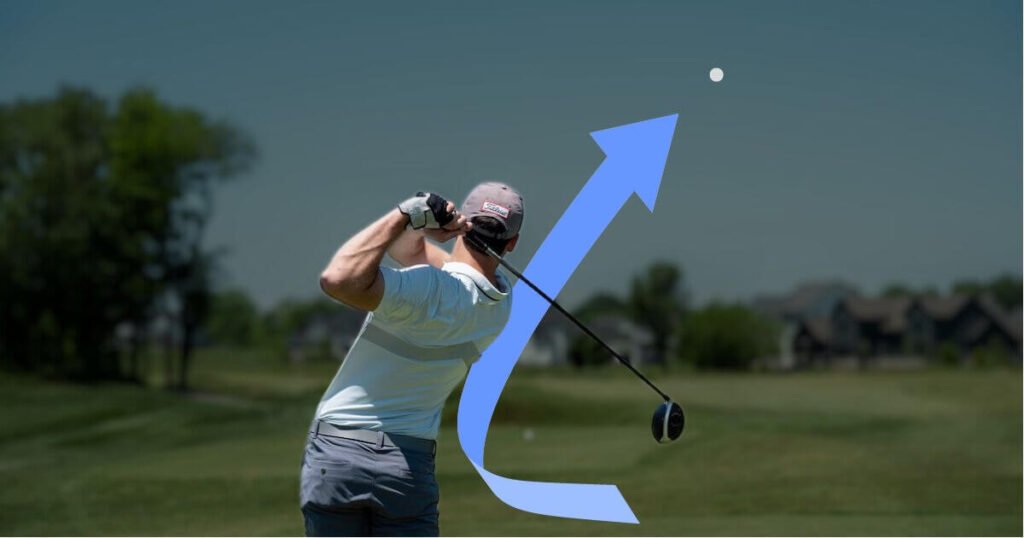
What Causes a Golf Slice?
Before you can fix a slice you first need to pinpoint the root cause. The main culprit of a slice in golf is an open clubface, meaning the face is turned away from you at impact. If the clubface is open at the point of contact, it will put side spin on the ball. This spin causes it to curve to the right (for right-handed golfers).
An open clubface can typicaly be traced back to an incorrect grip, an improper stance, or an outside-in swing motion. These issues usually arise due to a poor initial setup or having the wrong swing path. Let’s review these causes in more detail to help you understand the mechanics behind a golf slice. Then we will dive into how to fix a slice.
Outside-In Swing Path
This is one of the most common causes of a slice and can wreak havoc on your golf game. This means the club starts on an outside track during the backswing, then comes in toward your body during the downswing. This action causes the clubface to cut across the ball, adding side spin and resulting in a slice.
If you have a background playing baseball or softball, this is likely the culprit of your slice. Those sports develop a swing more on the out-to-in path. This ingrained habit can persist when one transitions to golf. An outside-in swing path doesn’t just contribute to a slice. It can also lead to loss of distance, inconsistent contact, and even golf-related injuries.
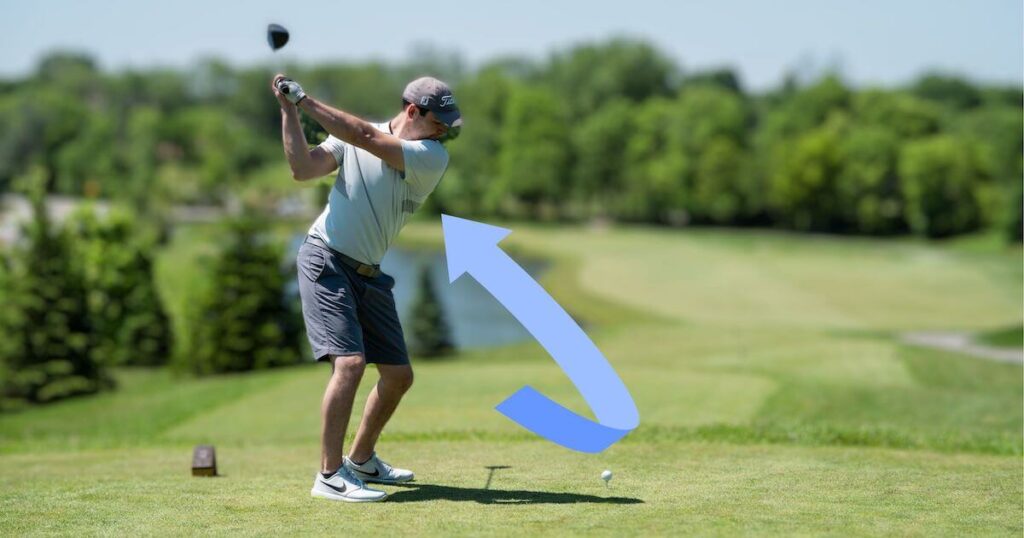
Improper Weight Shift
Correct weight transfer in a golf swing is crucial for the trajectory and direction of your ball. Poor weight transfer often originates from initiating your downswing with the upper body. Whereas a proper swing starts with your lower body shifting towards the target. Beginning with the upper body can throw off your balance, forcing you to lean backward. This motion, referred to as “hanging back”, results in the clubface being open at impact. Your body will compensate for the backward lean by speeding up the hands and arms to strike the ball. As a result, the club face fails to square up at contact.
Incorrect Grip
Not having a proper golf grip can put your club face in a position that promotes a slice. When the grip is too weak, meaning the hands are turned anti-clockwise at setup, it can can cause the clubface to remain open as you strike the ball. But what does a weak grip look like? Grab your club, address the ball, and then look down at your hands. If you only see one or even none of the knuckles on your left hand (for right-handed golfers), your grip is likely too weak. Try a more neutral or even strong grip to see if this helps your golf slice.
Poor Setup at Address
Poor setup, particularly misalignment on the tee box, can lead to a slice. It’s crucial to align your body parallel to the target line. This will encourage a more effective inside-out swing path. For right-handers, if your body is aimed to the left of the target line, it may promote an outside-in swing path. Which won’t help your slice.
Additionally, incorrect ball position in your stance can further contribute to a slice. If the ball is too far back, it can throw off the timing of your release, causing the clubface to stay open at contact.
7 Tips: How to Fix a Slice in Golf
Correct Golf Grip
A neutral or strong golf grip helps to promote a closed clubface and reduce side spin that makes the ball slice. Your hands should form a ‘V’ shape when holding the club. The crease between your thumb and index finger of your right hand should point at your right shoulder (for right handed golfers). If that crease points at your chest, your grip may be too weak. Your grip should be firm but relaxed. This allows you to maintain control without restricting the natural swing motion.
Here is a great video from Rick Shiels Golf on how to hold your club.
Proper Setup and Alignment
Setup starts with aligning your body to the target line. Avoid the common mistake of aiming your body at the target. Instead, your body should aim just to the left of the target (for right-handed players). This accounts for the distance between you and the ball. For your golf stance, your feet, knees, hips, and shoulders should all be parallel to the target line. Your feet should be shoulder-width apart, forming a solid base for your swing. Distribute your weight evenly between both feet to maintain balance throughout the swing. Keep your knees slightly bent, allowing for flexibility and power.
Additionally proper ball placement is an integral part of the setup. For a driver, the ball is positioned in line with the inside heel of your front foot. The ideal ball position moves back in your stance for each successive club down from the driver, with short irons centered between your feet, and wedges a bit off center toward your back foot.
Adjust Your Swing Path
Swing path is the direction your club takes to the ball during your golf swing. An optimal swing path follows an ‘in-to-out’ direction as opposed to an ‘out-to-in.’ To visualize this, imagine your golf ball is at the center of a clock face. Your goal is to hit the ball such that your club is moving up towards one o’clock (for right-handers) at impact. This aids in maintaining a square clubface and enhances shot accuracy.
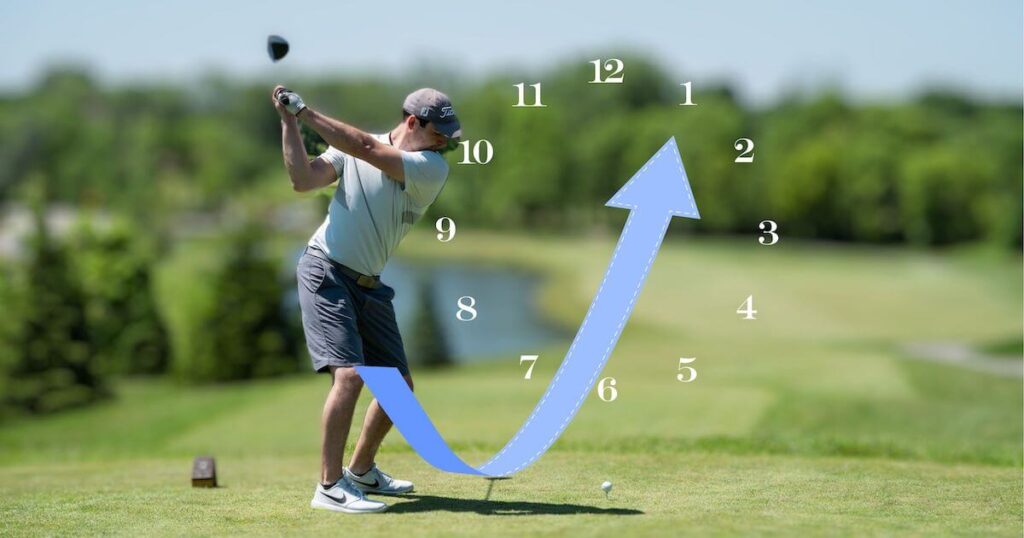
As noted above, a crucial aspect of your swing path is the correct weight transfer and initiation. Contrary to intuition, the downswing should be initiated with your lower body (hips/legs) rather than your upper body. Transfer your weight smoothly from your back to your front foot at the start of your downswing. Then rotate at the waist and follow through with your arms. This motion generates power from the ground up, for optimum energy transfer to the golf ball and supports an ideal swing path for straighter shots.
Release the Club Head
The release in a golf swing refers to the action of the hands and the club head through and after impact with the ball. Often described as “letting go,” it’s a crucial part of the golf swing as it ensures that your clubface is square and aimed at the target during contact.
As you begin your downswing, your wrists should remain hinged or “cocked.” This stores up potential energy, like a coiled spring. As your hands drop to hip height, you should begin to unhinge your wrists, allowing the club head to start catching up to your hands. At impact, your hands should be slightly ahead of the ball, with the clubhead square to the target line. After impact, the right hand and forearm should roll over the left, pointing the club at the target before finishing over your shoulder at follow-through.
Focus On Swing Speed and Tempo
While you certainly don’t want to swing as hard as possible (a guaranteed way to exacerbate your slice), swinging too slow can also have the same result. This happens because a slower swing speed doesn’t allow for the clubface to align correctly with the swing path before the point of impact with the ball.
However, it’s not just about speed; control is equally important. Swinging with too much speed can disrupt your balance and timing, causing inaccurate and inconsistent shots. This is where tempo comes into play. Tempo refers to the rhythm or pacing of your swing from start to finish. A good tempo allows for a smooth yet forceful motion, balancing power and control.
Check Your Clubs
In addition, you may want to assess whether your clubs help or hurt when it comes to fixing a slice. Here are a few things to look for:
Shaft flexibility
Flexibility refers to how much your club shaft bends during your swing and ideally should suit your swing speed. If the shaft is too stiff, it may not provide the optimal trajectory and spin for your specific swing speed, leading to off-center hits. Conversely, a shaft that’s too flexible might produce too much clubface rotation, which can also lead to mis-hits. If you have a relatively fast swing speed, a shaft with too much flex could contribute to your slice.
Adjustable Club Head
Additionally, check to see if your driver has an adjustable club head, as this can also assist in combating a slice. Most modern drivers can alter the loft and lie of the club head and adjust the weight distribution. By shifting the weight toward the heel of the club, you can encourage the clubface to be more square at impact. Some drivers even offer adjustable hosel settings that allow for changes in loft and lie, which can further help combat a slice. These adjustments should be made incrementally and ideally under professional guidance to ensure the correct setup.
Club Forgiveness
Furthermore, you may consider buying clubs or a driver that is designed to be more forgiving. For instance, the Ping G400 SFT (Straight Flight Technology) and the Callaway Rogue ST Max D are engineered with specific features to help reduce slices or assist in hitting a draw. Also some irons, such as Stix Golf Clubs, have greater forgiveness and a draw bias to help correct a slice. While a new driver can help, perfecting your swing and learning how to fix a slice will yield more consistent results.
Analyze Your Swing or Take Some Lessons
Getting professional support always helps. The best way to fix a slice in golf is to analyze your swing and determine what aspect is causing it. Start by having a professional check your grip and setup, then work on fixing any swing issues that may be causing a slice.
Training Exercises to Fix a Slice in Golf
The Hank Haney Slice Fix Drill
Hank Haney’s 5 Minute Slice Fix Drill is a renowned golf training method that aims to fix a slice in golf quickly and efficiently. The drill consists of three parts and is designed to re-route your swing to get you hitting draws. It starts with a simple clockwise circle and includes other steps that help you diagnose and fix problems with your golf swing. This 5-minute drill has been proven effective, even helping as many as 60 slicers in one instance. Whether you’re practicing at home or at the range, this drill can be a valuable tool to help eliminate slices from your game. Here is a ideo of the drill from Golf Digest.
The Tee Drill
Additionally, the Tee Drill is a highly effective exercise that targets the swing path, a common issue for those who struggle with a slice in golf. Place a tee peg in the ground just inside your leading foot (left foot for right-handed golfers). As you swing your club, your objective should be to avoid knocking the tee out of the ground. If you find that you’re frequently knocking the tee out of the ground, it suggests that your club is moving on an ‘out-to-in’ swing path.
The Basket Gate Drill
Finally, the Basket Gate Drill is another effective exercise to combat a slice in golf. To perform this drill, you need to set up two baskets or cones to create a ‘gate’ for your golf club to swing through. Position the baskets slightly wider than your clubhead and ensure they are aligned with your target. You aim to swing the club through the ‘gate’ without contacting either basket. Like the tee drill, this drill encourages an in-to-out swing path.
Here is a great demonstration of this drill from Matt Linberg Golf.
Conclusion: How to Fix a Slice in Golf
A slice in golf can be a frustrating hurdle, but it can be overcome with the right approach. As you’ll recall, a slice often occurs due to an open clubface or an improper swing path. While a driver that suits your swing style can make a considerable difference in fixing a slice off the tee, a firm grasp of your setup and swing mechanics will aid in resolving the primary causes of your slice and result in more accurate shots all around. Ultimately, golf is a game of finesse and control, and eradicating a slice may require patience and persistent effort. But with time and practice, you can expect to see an improvement in your swing, which will reduce and eventually eliminate slicing from your game.


